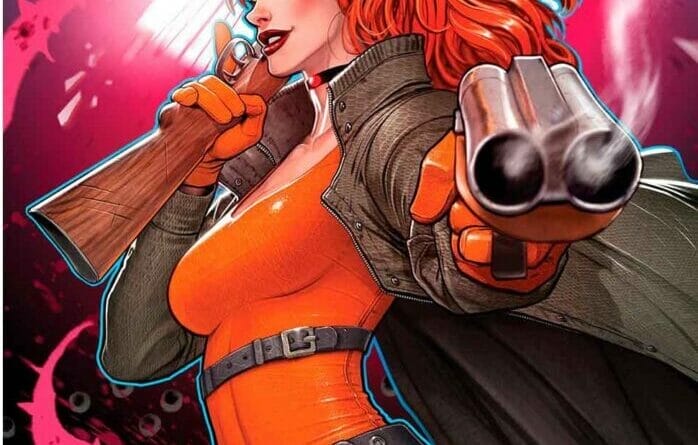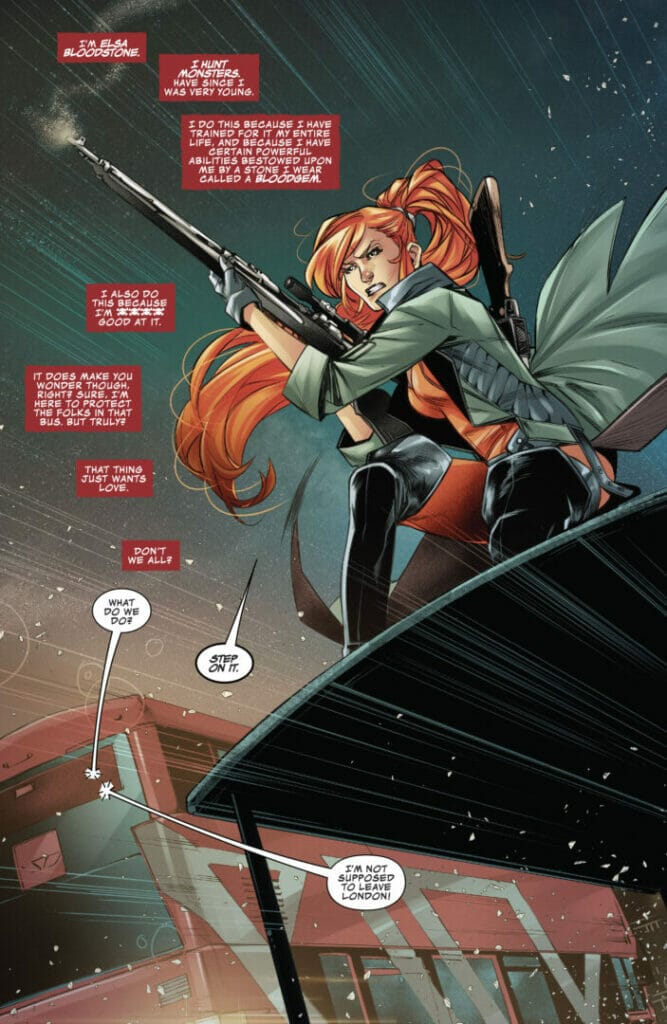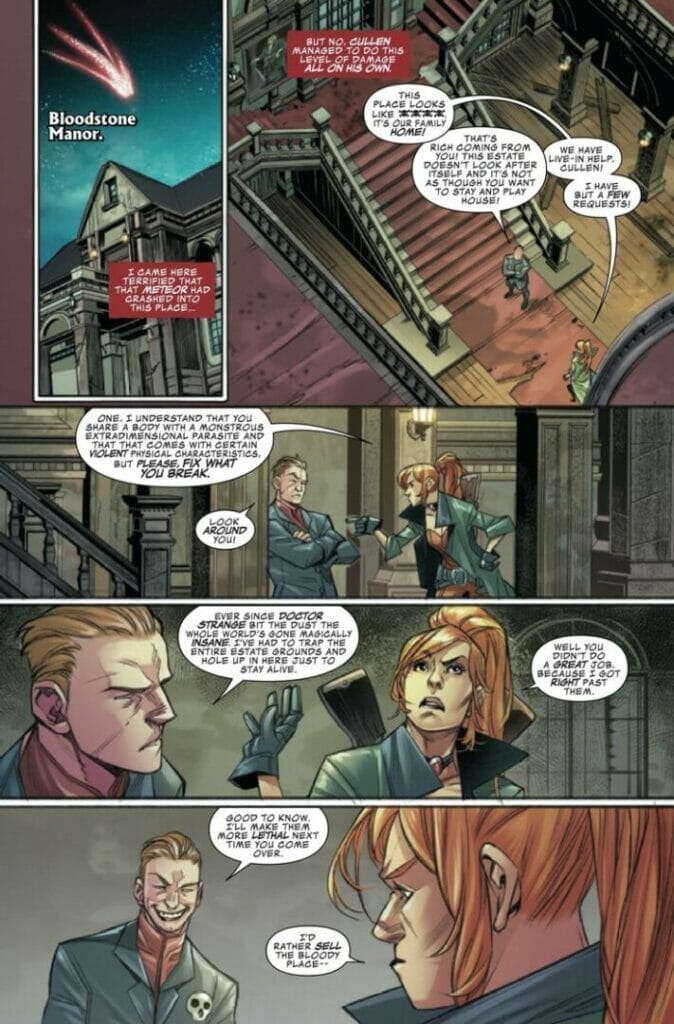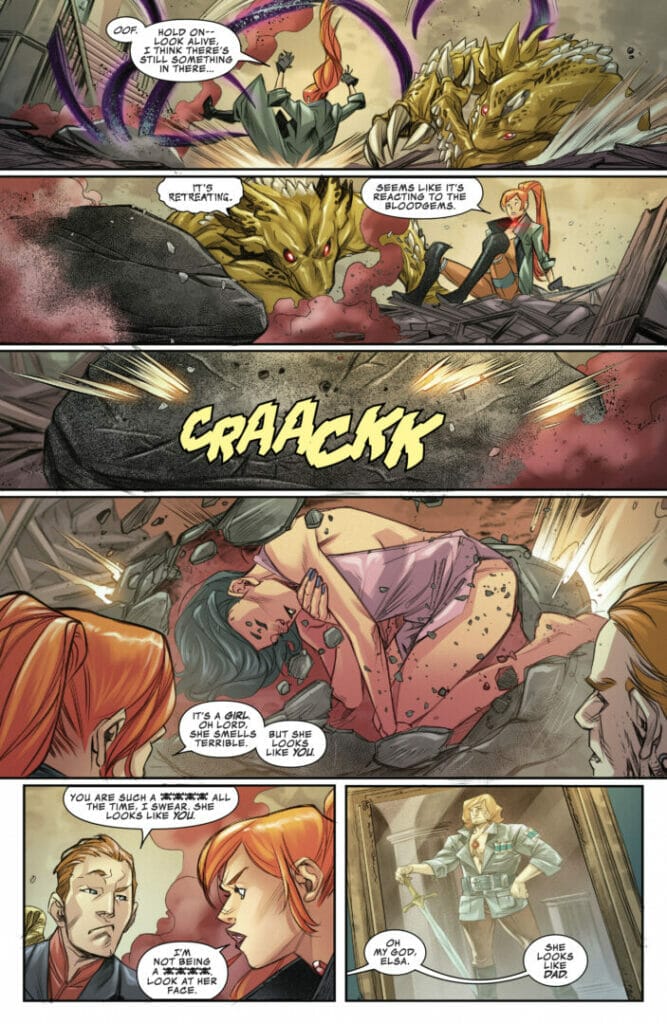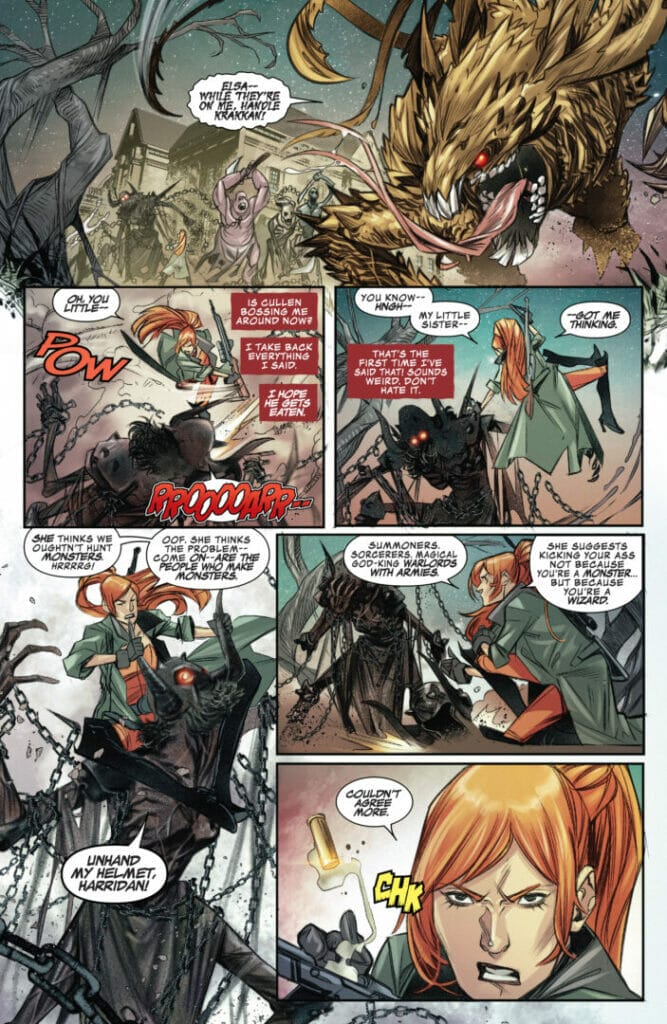**THIS ARTICLE CONTAINS SPOILERS FOR ‘THE DEATH OF DOCTOR STRANGE: BLOODSTONE #1’
The Death of Doctor Strange: Bloodstone #1 by Tini Howard, Ig Guara, Dijjo Lima, and VC’s Joe Caramagna sees monster-hunter Elsa Bloodstone return to her family estate after seeing a meteor barreling towards it whilst out on patrol. She returns home to find her house, not at the center of a crater, but destroyed by her brother Cullen’s inability to control his magical parasite Glartrox. Their sibling dispute is cut short by the meteors’ actual arrival, revealing a girl who looks like their father. Lyra Bloodstone is introduced into the Marvel universe, and she is ready to flip the script on Elsa’s monster-hunting career and her Bloodgem.
Following the magical madness of the preceding events in the main Death of Doctor strange theory, Bloodstone #1 works to demonstrate the mayhem brought about by the passing of Stephen Strange, regardless of the introduction of any backups he’s stored away in the cosmos. The introduction to this story with street-level action widens the scale of The Death of Doctor Strange storyline, as well as presents the general kind of action we may see Elsa and her siblings take on within the future. Moreover, the imagery of a hulking monster running around the streets on all fours invokes a similar sequence within the 2004 Hellboy film, further showcasing the kind of gritty occult action that Bloodstone shall depict.
The dialogue written by Tini Howard offers solid characterization for Elsa and Cullen, especially for those readers who may not have an established understanding of the duo. Aside from having Elsa directly acknowledge Cullen as her brother, the two’s immediate resort to berating and cursing each other out naturally establishes that good old fashion sense of sibling resentment. The casual references to Cullen’s parasitic relationship with the monster Glartrox are able to reveal the Bloodstone siblings’ long-standing relationship with magic in a similarly natural way.
However, the natural flow of the story is heavily stunted with the introduction of Lyra Bloodstone. Whilst Lyra presents an interesting new player into the magic side of the Marvel Universe, her introduction is shrouded within the exposition of explaining where she comes from and her association with Ulysses Bloodstone, the family patriarch. This exposition carries over to the introduction of the Nullgem, specifically in regards to association with Bloodgems.
However, Lyra’s character offers an interesting theory about monsters and monster hunters. As she has observed the cosmos for millennia, Lyra has come to realize the monsters themselves are not the cause of chaos or destruction, but the sorcerers and other magic users that created them. This philosophy was foreshadowed within the beginning action sequence of the issue, in which Elsa remarks that most monsters are acting on their base instincts rather than a sense of malcontent.
Howard making it so that this monster–friendly ideology was already unknowingly shared by the siblings allows them to unite in their beliefs extremely quickly yet in a rather smooth sense. Characterizing Lyra as being appreciative of the strife monsters go through allows the reader to warm to her rather quickly; feelings of warmth towards Lyra is contrasted by the fact that her ideology directly antagonizes major sorcerer characters and magic users that readers are attached to, and with the implication of Lyra attending Strange Academy, some major conflicts could arise the put readers on edge. Lyra’s effect on pre-existing marvel characters can already be felt in interactions with Cullen and Glartrox, as she has allowed Glartrox to be banished whenever Cullen wishes, showcasing Lyra’s abilities and offering Cullen’s character a new lease on life.
Aside from the implications for the wider universe introduced alongside Lyra, the highlight of the issue was the pencils and coloring from Ig Guara and Dijjo Lima. Guara’s illustration offers the issue with a backdrop of eldritch horrors, such as when Lyra consumes the magical artifacts within the Bloodstone estate, with her blackened eyes and dark veins appearing on her body. Another example of Guara adding a touch of horror to the piece is the appearance of Krakkan the jailer, with the depiction of a skeletal warrior suggesting his existence as an ancient threat and his black armor and stature alluding to characters such as Sauron.
Next to the penciling is the vibrant coloring offered by Lima, offering the traditional scale in Marvel’s magic conflicts through the painting of blue flames illuminating the battlefield, the yellow scales of Glartrox carving through Krakkan’s hordes, and the deep fire within the eyes of the jailer being made all the more menacing with shades of crimson.
The Death of Doctor Strange: Bloodstone #1 is a much stronger spinoff issue than it had any right to be, especially when contending with the antics of Devil’s Reign and the main Death of Doctor Strange storyline. Tini Howard was able to utilize this small scale to its fullest effect however through the introduction of smaller stakes that can ripple out through the entirety of Marvel’s universe, namely Lyra and the new ideology that she possesses that is a strictly anti sorcerer.
With Elsa’s family now clashing with her magic using allies such as Stephen Strange, this issue calls into question how she will be able to balance each relationship and not lean too far to one extreme. With the introduction of Lyra Bloodstone and Nullgem, it wouldn’t be surprising if the Marvel universe begins to observe magic users in a very different light.
The Death of Doctor Strange: Bloodstone #1 is available now in digital and your local comic book shop.
Want to discuss things further? Hit us up on Twitter, Facebook, or Instagram. And for more film, gaming, anime, and TV news, trailers, and updates make sure to keep it locked right here at The Nerdy Basement. While you’re here, please consider supporting us on Patreon! It’s an easy way of supporting us so we can keep proving you with your Nerdy News!

